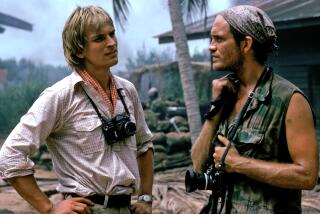Hollywood Never Could Resist a Mummy
- Share via
Ancient Egypt holds out three magnets for movie makers: its connections to the Bible through Moses and Joseph, the eternal allure of Cleopatra and, above all, the mystery of mummies. It is the last of the trinity that brings forth one of the summer’s big sequels, “The Mummy Returns.”
The grandeurs of early civilizations gripped the minds of filmmakers since the days of the early Italian cinema and the first epic by D.W. Griffith, the 1913 “Judith of Bethulia.” But with the discovery of the tomb of the Pharaoh Tutankhamen by Howard Carter in 1922, Egypt became the new craze. In 1923, Cecil B. DeMille made his first version of “The Ten Commandments,” combining the old and modern worlds in the manner of Griffith’s “Intolerance.” In 1934, DeMille filmed “Cleopatra,” with Claudette Colbert improbably cast as the queen of the Nile.
The Egyptian beauty seduced writers going back to Shakespeare and up through George Bernard Shaw. One of the most engaging portrayals of the land of the pyramids and temples comes in Gabriel Pascal’s 1945 film of Shaw’s “Caesar and Cleopatra,” with Claude Rains and Vivien Leigh in the title roles. That tale takes place mostly in Alexandria, but films about Marc Antony and Cleopatra move, like Shakespeare’s play, about the ancient world. The big moment in the huge Elizabeth Taylor-Richard Burton “Cleopatra” of 1963 is the march through Rome.
The ‘50s brought a new DeMille “Ten Commandments” in 1956 as well as two less successful excursions into Egypt, Michael Curtiz’s 1954 version of the Mika Waltari’s best-selling “The Egyptian,” and Howard Hawks’ 1955 “The Land of the Pharaohs.” The architecture of these wide-screen spectacles shows why Egypt fascinated directors, and the best thing about the retelling of the Moses story in DreamWorks’ brilliantly animated “The Prince of Egypt” is the hypnotic look of the sunny Nile and the shadowy grand palaces of the pharaohs.
The mummy, entombed in a gorgeous coffin, wrapped in strips of cloth and still recognizable as a human being after hundreds of years, has exerted a stronger hold on filmmakers than even Cleopatra or Moses, however. In 1932, fresh from “Frankenstein,” Boris Karloff collaborated with the German master cinematographer Karl Freund on “The Mummy.” The short, richly atmospheric film spawned a number of sequels and remakes, including the 1959 version with Peter Cushing and Christopher Lee, and the recent 1999 version starring Brendan Fraser as a would-be Indiana Jones.
There are many “Mummy” titles, including “Blood From the Mummy’s Tomb” and “I Was a Teenage Mummy” (two versions). And, of course, there is the ever-amusing, eternally silly “Abbott and Costello Meet the Mummy” (those two met everybody).
More to Read
Only good movies
Get the Indie Focus newsletter, Mark Olsen's weekly guide to the world of cinema.
You may occasionally receive promotional content from the Los Angeles Times.










